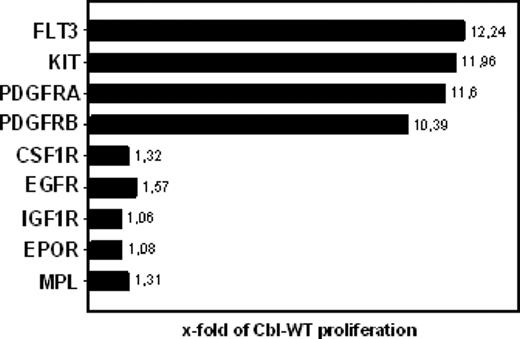Abstract
Abstract  2447
2447
We examined the oncogenic potential of CBL deletion mutant found in AML patients in cytokine receptor and receptor tyrosine kinase (RTKs) expressing cells. In addition, we analyzed the interaction sites of FLT3/CBL and the critical pathways activated by CBL deletion mutants.
RTK, CBL and AKT constructs were expressed in Ba/F3 cells via a retroviral expression vector. Stable protein expression after transduction and fluorescence-activated cell sorting (FACS) was confirmed by western blotting and cellsurface-marker expression of receptors by flow cytometry. Cell Proliferation and apoptosis assays were done in presence and absence of IL-3 or receptor-ligands.
Coexpression of RTK III-WT (PDGFRA, PDGFRB, FLT3, KIT) and CBL deletion mutants cause IL-3 independent and ligand dependent growth of Ba/F3 cells. RTK III-WT/CBLΔexon8 cells show a more than 10 fold hyperproliferation in response to ligand stimulation. In contrast Non-class III receptor tyrosine kinases (EGFR, EPOR, MPL, IGF1R) and CSF1R show just a very weak hyperproliferation if coexpressed with the CBL deletion mutant. Selective protein tyrosine kinase inhibitors abrogate this proliferation. In cells coexpressing RTK-III receptor and CBLΔexon8 the receptor internalization is delayed and cells were protected from apoptosis after cytokine withdrawal. Ba/F3 cells after ligand stimulation and AML cell lines coexpressing CBL deletion mutants and FLT3 show an enhanced AKT phosphorylation. The PI3K inhibitor LY294002 and the AKT inhibitor MK2206 abolish the CBL mutant mediated hyperproliferation. Furthermore, a combined pharmacological inhibition of PI3K/AKT pathway and RTK shows an additive effect. The transforming potential of the CBL mutant is completely abolished by a mutated PTB domain of CBL (G306E) and decreased by mutation of tyrosines 589 and 591 in the juxtamembrane domain of FLT3. A constitutive active AKT mutant (E17K) recapitulates the CBL deletion mutant induced phenotype in Ba/F3 cells.
Hyperproliferation of Ba/F3 cells coexpressing indicated receptors and CBL deletion mutant is quoted as X-fold of CBL wildtype coexpressing cells.
Hyperproliferation of Ba/F3 cells coexpressing indicated receptors and CBL deletion mutant is quoted as X-fold of CBL wildtype coexpressing cells.
No relevant conflicts of interest to declare.
Author notes
Asterisk with author names denotes non-ASH members.

This icon denotes a clinically relevant abstract


This feature is available to Subscribers Only
Sign In or Create an Account Close Modal